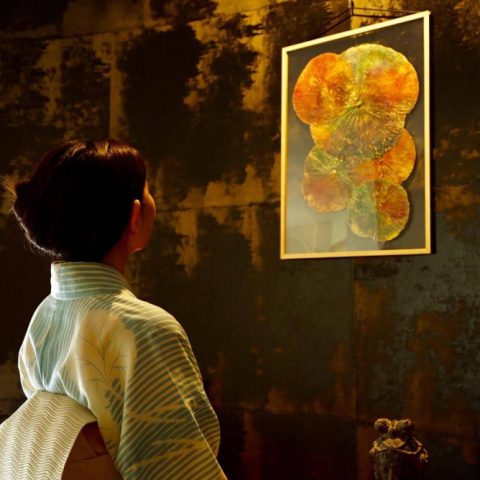
Origin and History of Rice Paddy Art
Rice paddy art is a form of agricultural art that is created by planting different coloured rice seedlings in a rice field to create a specific image or pattern. The art form originated in Japan, where it is known as shokudo zushi (literally “rice field pictures”). The earliest known examples of rice paddy art dates back to the Edo period (1603-1868), but the art form became more popular in the 20th century.

The Empress’s image created in the paddy fields – Credit: Quinta Japonesa https://www.pinterest.ch/quintajaponesa/
Technique of Rice Paddy Art
Rice paddy art is created using different coloured rice seedlings in a rice field to create an image or pattern. The colours of the rice seedlings are determined by the type of rice that is planted. For example, white rice seedlings will create a white image, while red rice seedlings will create a red image.
The process of creating rice paddy art is very labour-intensive. The first step is to prepare the rice field by levelling the ground and removing any weeds. Then, the different coloured rice seedlings are planted in the field according to the desired image or pattern. The seedlings are planted very close together, so that they will blend together to create a solid colour. After the seedlings are planted, the rice field is watered regularly. The seedlings will need to be watered several times a day, especially during the hot summer months. The rice field will also need to be weeded regularly, to prevent weeds from overtaking the seedlings.

Rice paddy art – Credit: yawning hunter
Importance of Rice Paddy Art
Rice paddy art is a beautiful, unique, and sustainable form of art that is important to Japanese culture and history. It is a way to celebrate the beauty of nature, the importance of agriculture, and the rich history of Japan. Due to the fact that the images are made using natural rice seedlings, the art is not harmful to the environment, and it can be enjoyed by people of all ages.
In addition to its beauty, rice paddy art is also a way to connect people with the land and the natural world. The images created in rice paddy art are often peaceful and harmonious, inspiring people to be creative and to think outside the box.
Overall, rice paddy art is a valuable asset to Japanese culture and history. It is a beautiful, sustainable, and educational form of art that can be enjoyed by people of all ages.

Sazae-san – Credit: Telegraph.co.uk
Role of Locals in Rice Paddy Art
The local community plays an important role in rice paddy art. They help to promote the art form by organising festivals and events that showcase their creations. The farmers who own the fields are responsible for planting and caring for the rice seedlings. In addition to the farmers, many other local people are involved in rice paddy art. Local businesses often sponsor festivals, and local volunteers help to plant and care for the seedlings.

Osamu Tezuka Anniversary of birth drawn in rice fields – Credit: bbc.com
Children are also involved in rice paddy art, and they often help to plant the seedlings and water the fields. Kids love rice paddy art, and it provides them with a fun and creative way to learn about agriculture. They also enjoy the challenge of planting the rice seedlings in the correct pattern. Watching the seedlings grow and change colour is also a rewarding experience.

Tourists enjoying Marilyn Monroe striking her iconic white dress pose grown in Japanese Rice field -Credit: dailymail.co.uk
Interest Among Tourists
Rice paddy art is a popular tourist attraction in Japan. Due to this the unique art form has become increasingly popular in photography and paintings, capturing the hearts and minds of viewers who are unable to see their beauty in person.
With this in mind, rice paddy art provides a great way to promote tourism in rural areas. Visitors from all over the world come to see the beautiful images and patterns that are created in the rice fields. This helps boost the local economy and to preserve the traditional way of life in rural Japan.

The Mona Lisa in rice paddy field art – Credit: Ronin Dave
Popular Areas for Rice Paddy Art in Japan
There are many areas in Japan that are famous for rice paddy art, but some of the most popular include:
- Inakadate in Aomori Prefecture:
Inakadate is known for its large-scale rice paddy art, which has been featured in international media. The town has been holding rice paddy art festivals since 1993, and the images created in the fields have included Mount Fuji, the Great Wave off Kanagawa, and the Mona Lisa.
- Yuasa in Kyoto Prefecture:
Yuasa is known for its traditional rice paddy art, which is created using the katazome technique. Katazome is a method of dyeing fabric to use as stencils, and it is often used to create delicate and intricate patterns. The rice paddy art in Yuasa is typically created using katazome to create images of flowers, animals, and other natural motifs.
- Shingu in Wakayama Prefecture:
Shingu is known for its rice paddy art that is inspired by the Shinto religion. The town is home to the Kumano Kodo, a pilgrimage route that is considered to be one of the most sacred in Japan. The rice paddy art in Shingu often features images of gods and goddesses, as well as symbols of the Shinto faith.
- Kagawa Prefecture:
Kagawa Prefecture is home to many small villages that are known for their rice paddy art. The art in Kagawa is often created using traditional methods, and it typically features images of local landmarks and festivals.

Mount Fuji – Credit: designboom
Amazing Fun Facts
- The colours of the rice seedlings are determined by the type of rice that is planted. The most popular colours used in rice paddy art are white, red, blue, and yellow.
- The largest rice paddy art image ever created was in 2015 in Inakadate, Japan. The image was of Mount Fuji and it was over 120,000 square metres in size.
- Rice paddy art can only be seen during the growing season, which is from April to September.
- Some farmers use drones to help them plant and care for the rice seedlings.
- Rice paddy art is a sustainable form of art, as it does not use any chemicals or pesticides. This makes it a popular choice for people who are looking for a more environmentally friendly way to enjoy art.
Make sure to enjoy these attractive masterpieces created by local hands of the Japanese people on your next trip to Japan. We can promise you that you will not be disappointed by the grandness of this great, historical art form.
Feature image credit: maharo625
Book your local guide during your trip to Japan to learn more about traditions and local stories!



